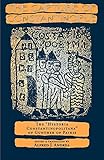The Capture of Constantinople : The "Hystoria Constantinopolitana" of Gunther of Pairis / Alfred J. Andrea.
Material type: TextSeries: The Middle Ages SeriesPublisher: Philadelphia : University of Pennsylvania Press, [2010]Copyright date: ©1997Description: 1 online resource (208 p.)Content type:
TextSeries: The Middle Ages SeriesPublisher: Philadelphia : University of Pennsylvania Press, [2010]Copyright date: ©1997Description: 1 online resource (208 p.)Content type: - 9780812215861
- 9780812201130
- 949.61/8013 21
- D164.A3 G813 1997eb
- online - DeGruyter
- Issued also in print.
| Item type | Current library | Call number | URL | Status | Notes | Barcode | |
|---|---|---|---|---|---|---|---|
 eBook
eBook
|
Biblioteca "Angelicum" Pont. Univ. S.Tommaso d'Aquino Nuvola online | online - DeGruyter (Browse shelf(Opens below)) | Online access | Not for loan (Accesso limitato) | Accesso per gli utenti autorizzati / Access for authorized users | (dgr)9780812201130 |
Browsing Biblioteca "Angelicum" Pont. Univ. S.Tommaso d'Aquino shelves, Shelving location: Nuvola online Close shelf browser (Hides shelf browser)

|

|

|

|

|

|

|
||
| online - DeGruyter Human Rights Under African Constitutions : Realizing the Promise for Ourselves / | online - DeGruyter African Constitutionalism and the Role of Islam / | online - DeGruyter This Is Our Music : Free Jazz, the Sixties, and American Culture / | online - DeGruyter The Capture of Constantinople : The "Hystoria Constantinopolitana" of Gunther of Pairis / | online - DeGruyter Human Rights in Turkey / | online - DeGruyter Masking Terror : How Women Contain Violence in Southern Sri Lanka / | online - DeGruyter Inquisition and Power : Catharism and the Confessing Subject in Medieval Languedoc / |
Frontmatter -- Contents -- Preface -- Abbreviations -- Introduction -- The Capture of Constantinople -- Notes -- Bibliography -- Index
restricted access online access with authorization star
http://purl.org/coar/access_right/c_16ec
The armies of the Fourth Crusade that left Western Europe at the beginning of the thirteenth century never reached the Holy Land to fight the Infidel; they stopped instead at Byzantium and sacked that capital of eastern Christendom. Much of what we know today of those events comes from contemporary accounts by secular writers; their perspective is balanced by a document written from a monastic point of view and now available for the first time in English.The Hystoria Constantinopolitana relates the adventures of Martin of Pairis, an abbot of the Cistercian Order who participated in the plunder of the city, as recorded by his monk Gunther. Written to justify the abbot's pious pilferage of scared relics and his transporting them back to his monastery in Alsace, it is a work of Christian metahistory that shows how the sack of Constantinople fits into God's plan for humanity, and that deeds done under divine guidance are themselves holy and righteous.The Hystoria Constantinopolitana is one of the most complex and sophisticated historiographical work of its time, deftly interweaving moods and motifs, themes and scenes. In producing the first English translation and analysis of this work, Alfred Andrea has captured the full flavor of the original with its alternating section of prose and poetry. His introduction to the text provides background on Gunther's life and work and explores the monk's purpose in writing the Hystoria Constantinopolitana-not the least of which was extolling the virtues of Abbott Martin, who was sometimes accuse of laxity by his superiors in the Order.Gunther's work is significant for its effort to deal with problems raised by the participation of monks in the Crusades, making it a valuable contribution to both crusading and monastic history. The Capture of Constantinople adds to our knowledge of the Fourth Crusade and provides unusual insight into the attitudes of the participants and the cultural-intellectual history of the early thirteenth century.
Issued also in print.
Mode of access: Internet via World Wide Web.
In English.
Description based on online resource; title from PDF title page (publisher's Web site, viewed 26. Aug 2020)


